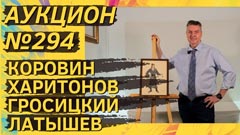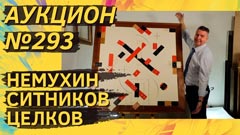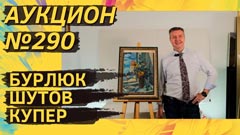
1960s UNOFFICIAL ART
STEINBERG Eduard Arkadevich (1937–2012) Composition (dedicated to Ilya Kabakov). 1975. Oil on canvas. 120 × 140
A whole cycle of pictorial dedications to like-minded people, friends and associates in the art underground can be distinguished in the work of the sixties artist Eduard Steinberg. In particular, he has a dedication to Viktor Pivovarov, a dedication to Dmitry Krasnopevtsev and now a dedication to Ilya Kabakov. Steinberg never made homages “directly”. He never stylized himself “in the image of someone” and almost never used the tools of the “dedicated”. Very occasionally, he introduced an obvious element — for example, the characteristic dry twig in the dedication to Krasnopevtsev. But that is all. But more often, Eduard Steinberg had enough of his signature Suprematist primary symbols to recreate the recognizable compositionality of his colleagues' paintings. Steinberg speaks a dialect of Malevich's language, enriching the ideas of Suprematism and creating a new direction.
For his dedication to Kabakov, the artist chose the conceptualist classics — characteristic minimalism and koan aesthetics. What is missing? Kabakov often relied on text in his enigmatic pieces. But Steinberg shied away from this, although he himself often used a similar narrative technique. However, the problem was solved even without it. And now we have a meter and a half museum-class masterpiece, in which the concepts of the two co-thinking members of the Sretensky Boulevard group came together.
A few words about the hero of the occasion. Ilya Kabakov is considered to be a key figure in Moscow conceptualism and the most famous representative of Russian post-war art in the West. The inventor of the idea of “total installation” heads the list of the most expensive living Russian artists. His auction record is $5.8 million.
KHARITONOV Alexander Vasilyevich (1931–1991) An encounter. 1978. Oil on canvas. 21 × 28
An expensive, rare and highly sought-after by collectors artist. Alexander Kharitonov represented the neo-symbolist wing in the unofficial post-war art. In a creative sense, he was the heir to the philosophy of Nesterov and Roerich. The heroes of his works were saints, angels and religious people. His colleagues in the Lianozovo group called him “the Preacher of Good”. Kharitonov invented a special divisionist (pointillist) style of painting, which from a distance resembled Old Russian beadwork.
Despite the high technical labor-intensiveness and complexity of the “beadwork” technique, which usually protects against fakes, Kharitonov belongs to a risk group of artists. Fakes are not uncommon. Therefore, an expert opinion is a prerequisite for the purchase. “An encounter” is accompanied by a paper by Valery Silaev, who notes its mystical atmosphere, silence, peace, mystery and purity.
ZVEREV Anatoly Timofeevich (1931–1986) Self-portrait in a striped vest. 1957. Oil on paper. 60 × 42
Zverev's self-portraits, especially in his youth, in the 1950s, are often recognized as creative successes of the artist. And this is no coincidence. Self-portrait for Zverev is not just a confessional genre, but a creative laboratory. He searches, analyzes and tests. And here he is absolutely free in the creative sense and acts completely without regard for customers. After all, a self-portrait is yours and yours alone.
“Self-portrait in a striped vest” is painted in the tube technique. Zverev works without brushes. He squeezes the paint directly onto the paper and uses the tube as a palette knife. The vivid expressionist style, energy and power of this work left no choice to the expert Valery Silaev: his verdict is “of museum value”.
TSELKOV Oleg Nikolaevich (1934–2021) Four black sculptures. 2011. Porcelain. Factory Höchster Porzellan-Manufaktur
According to the legend, which was confirmed by Tselkov himself, the idea of muzzle-faces was born in his art by chance, but took hold of him for the rest of his life. The artist realized that in this new biomorphic language he could describe the whole world around him. Whether it was a freak with a fork or a shot glass, it didn't matter. The result is that Tselkov's work cannot be confused with anyone else's, if you only see it once.
The black sculptures are the only experience of transferring Tselkov's planar pictorial images into small sculptural plastic. These sculptures were produced twelve years ago at the German factory Höchst in a small edition of 15 copies. It has long been dispersed among collections. It is expensive. Perhaps the set left with us is the last chance to purchase this sculptural plastic for the foreseeable future.
Tselkov had a reputation as an enfant terrible in the art scene, even by the standards of the artistic underground. Attempts to begin exhibiting in the early 1960s were quickly foiled by “vigilant comrades”. Soon after his exhibition at the Architect's House (if you can call an exhibition an event where the lights were immediately turned off), he was expelled from the Union of Artists. In 1977, Tselkov left the country and worked in France. But in the Soviet Union he was remembered all this time, and after Perestroika, Tselkov triumphantly returned to the Russian audience. Today Oleg Tselkov is one of the most expensive and sought-after artists in the segment of unofficial art.
- Log in to post comments










